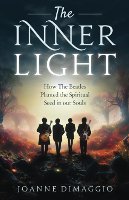
Image by octavio lopez galindo
In this Article:
- What is Soul Writing? Understand the meditative writing process.
- Can anyone do Soul Writing? Learn the basics and get started.
- Famous Examples: Discover how famous writers and composers used this technique.
- Why it Matters: The benefits of Soul Writing for creativity and spiritual growth.

What is Soul Writing, and Can Anyone Do It?
by Joanne DiMaggio.
Referred to as “Inspirational Writing” by Edgar Cayce, and wrongly labeled “Automatic Writing”, Soul Writing is best described as a written form of meditation. If you think of prayer as you talking to God, and meditation as God talking to you, Soul Writing is you taking notes. It is writing in an altered state of consciousness and it is a process that has been used for centuries by famous writers, composers, and artists.
In my first book, Soul Writing: Conversing With Your Higher Self, I explore what it’s like to write in an altered state of consciousness and all the ways it can be applied to your life, including using it to enhance your psychic abilities; in past-life exploration; obtaining guidance on specific topics; in various art forms; delving deeper into esoteric philosophies; in psychoanalysis and healing; writing for soul’s growth; and in service to others.
Many Famous Writers Were Soul Writers
In researching others who employed Soul Writing in their work, I learned of many famous writers who struggled to describe the process of inspiration. They knew they were being divinely influenced, but did not fully comprehend the source of that inspiration.
Musical composers obtain their inspiration the same way that literary writers do, recording that inspiration as musical notes rather than the written word. For instance, John Lennon’s method of writing the lyrics to “Across the Universe” is an example of how this type of guided writing manifests itself.
According to Steve Turner, John claimed the lyrics came to him while he was in bed at Kenwood. “. . . as he lay there trying to sleep, the phrase ‘pools of sorrow, waves of joy’ came to him and wouldn’t leave until he got up and started writing the words down,” Turner writes. He quotes John as saying: “It drove me out of bed. I didn’t want to write it. I was just slightly irritable and I couldn’t go to sleep.”
That same process revealed itself earlier when John Lennon wrote “Nowhere Man.” John claimed the song came from his subconscious. After spending hours trying to write something meaningful, he took a break. As he was resting, the words and music came to him, seemingly out of nowhere, and he felt compelled to write them down. This is as good a definition of Soul Writing as I can find.
Tapping Into the Creative Well
John’s description of how the lyrics came to him for “Across the Universe” and “Nowhere Man” had similarities to the process described by great writers and composers alike. I believe all people are creative in one form or another, but I wonder whether people like John are able to tap into a deeper well than others. My research discovered that many artists, composers, and writers have learned—whether by accident or intentionally—to access an unseen dimension that for them becomes an endless fountain from which their creative genius flows.
They reach that invisible world by entering an altered state of consciousness brought about by trance, meditation, or dreams. While in this altered state, the quality of their work reaches new heights, vastly different in style, tone and composition than work done in their waking state.
This is certainly what happened with John as the words “came to him” while he was in a quiet space. He was in good company. The English poet Percy Shelley writes: “One after another the greatest writers, poets, and artists confirm the fact that their work comes to them from beyond the threshold of consciousness.” That phrase—beyond the threshold of consciousness—is an apt description of meditation.
Rudyard Kipling admitted that the key to gaining access to his inner helper was “not to think consciously, but to drift,” also another way of describing meditation. Author Richard Bach had an experience that mirrored John’s. He was walking one day when he heard an inner voice repeat: “Jonathan Livingston Seagull.” He went home and began writing furiously, trying to keep up with the flow of words that were coming spontaneously to mind.
Music from the Soul
This inspirational process worked for famous composers as well. In describing his creative process, Wolfgang Amadeus Mozart writes: “Whence and how they come, I know not; nor can I force them.”
Beethoven says a “canon” came into his head while he napped during a carriage ride. When he awoke, he remembered it and committed it to paper.
Johannes Brahms told a biographer that the inspiration for his most famous compositions came to him from ideas that flowed through him from God. He admitted that he had to be “in a semi-trance condition to get such results—a condition when the conscious mind is in temporary abeyance, and the subconscious mind is in control.” Sound familiar?
Russian composer Tchaikovsky describes a similar process—an urgent sense of needing to write something down quickly: “I forget everything and behave like a mad man; everything within me starts pulsing and quivering...”
Composer Richard Strauss describes how music flowed through him: “It seemed to me that I was dictated to by two wholly different Omnipotent Entities . . . I was definitely conscious of being aided by more than an earthly Power, and it was responsive to my determined suggestions.”
Meditation: A Key Component for Soul Writing
Meditation is one of several key components necessary for soul writing. The time John Lennon and Paul McCartney spent with the Maharishi enabled them to learn the benefits of meditation and apply it toward their songwriting. George Harrison also commented on the need for quieting his mind when composing, telling Dr. Jenny Boyd: “I like quietness. I tend to write most of my songs in the night when the world goes to sleep for a bit and everything’s quiet.”
In discussing what could arguably be described as his greatest composition, Yesterday, Paul says: “The great thing about Yesterday is that it kind of wrote itself.” Meyers wrote that this factor concerned Paul so much that he worried he’d be accused of plagiarism as he didn’t feel that song was his.
This is a common retort among those experimenting with Soul Writing. The words that come to them are much deeper and more profound than anything they have ever written in a conscious state, leaving them to question their origin. John says something similar regarding “Across the Universe.” He said the words were purely inspirational and were given to him. As such, he couldn’t claim ownership.
Who Is Doing the Writing?
One of the most common questions I hear by those engaged in Soul Writing, is who is doing the writing? Is it their spirit guide? An angel? An ascended master? Source itself? Or perhaps a Muse?
I tell students of Soul Writing that they are the ones doing the writing. It is coming from a divine source, through their soul, and then out on paper. They did the writing themselves, with a little help from their friends.
Paul’s composition of “Let It Be” came about through much the same process. Meyers writes that Paul is “consistently clear that the experience felt like a visitation, a non-ordinary experience, rather than a thought or memory.” Meyers says the theme of ‘Let It Be’ is that Spirit is always with us and that Spiritual light is eternal. He acknowledges that Paul “crafted a timeless song that is healing, transfor-mative and inspired. ‘Let It Be’ invites us all to emotionally connect, to heal our initial spiritual amnesia, to reunite with eternal light.”
Those are the very concepts explored in great depth through the Soul Writing process—a process that Paul, John and George utilized in their song writing without really understanding what it was or where it originated.
How To Do Soul WritingTM
Soul WritingTM is a written form of meditation. It is you going into a meditative state through deep breathing and total relaxation, putting the pen to paper, and having a conversation with God, your Higher Self (Soul), Angels, Ascended Masters, Muse, or other divine emissaries. It is a 24-7 hotline, providing loving guidance on any issues facing you. It answers the “why” questions we all ask in a time of spiritual or physical crisis.
Soul Writing is something anyone can do—most get something on the first try. This form of meditative writing provides you with a profound connection to the Divine within, to the core of your being, and enables you to tap into the collective consciousness where answers to all of life’s—and death’s—questions can be found.
Here are a few steps to get your started:
-
Find a sacred place. Walk through your home and find your own sacred writing space with the aesthetic qualities most conducive to your connection to Spirit.
-
Set the stage. Surround yourself with items that remind you of your spiritual journey, such as music, artwork, crystals, candles, incense, etc.
-
Same time. Same place. If you consistently write at the same time and in the same place, you condition yourself to connect that much quicker.
-
Pen versus the keyboard. It’s a matter of preference. Experiment with both.
-
Meditation is Key. A silent entering into a peaceful state is essential.
-
Say a Prayer of Protection. Picture yourself surrounded by a bubble of bright, white light. Say a prayer of protection, asking that you be kept safe from all things seen and unseen that are not for your highest and best. Do not skip this step.
-
Focus on a question. Think about whatever is troubling you and form a precise question about it. If you do not have a specific question, ask for a message for your highest and best.
-
Get Ready to Write! If you get nothing on paper, but hear something in your head, write that down.
-
Allow the Message to Proceed. Do not edit for punctuation, grammar or spelling. This is stream of consciousness writing. You can ‘fix it’ later.
Copyright 2024. All Rights Reserved.
Adapted with permission.
Article Source:
BOOK: The Inner Light
The Inner Light: How The Beatles Planted the Spiritual Seed in our Souls
by Joanne DiMaggio.
For more info and/or to order this book, click here. Also available as a Kindle edition.
About the Author
 Internationally recognized Researcher, Teacher, Author, and Past-Life Therapist, Joanne DiMaggio, MA, CHt, has published six books and hundreds of magazine articles for both mainstream and esoteric audiences.
Internationally recognized Researcher, Teacher, Author, and Past-Life Therapist, Joanne DiMaggio, MA, CHt, has published six books and hundreds of magazine articles for both mainstream and esoteric audiences.
In 1987, Joanne began devoting all of her time to her esoteric studies, specializing in past-life exploration, research, and therapy. The years she spent researching and working on her own past lives, coupled with her experience as the director of her own past-life research organization, gives clients the comfort of knowing they are working with someone who has firsthand knowledge of the emotional, physical, psychological, and spiritual experience a past-life journey entails. She eventually combined her passion for soul writing™ with her knowledge of reincarnation and today is considered a respected expert in both fields.
Visit the author's website at: JoanneDiMaggio.com
More books by this Author.
Article Recap:
Soul Writing is a meditative process that connects the writer with their higher self, offering a channel for divine inspiration. This technique, historically used by famous writers and composers, involves entering an altered state of consciousness to enhance creativity and spiritual growth. By practicing Soul Writing, one can tap into deeper levels of understanding, access subconscious thoughts, and achieve personal and artistic breakthroughs.































